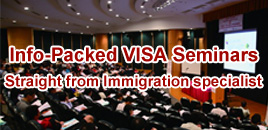




In 2023, it expects to have its third consecutive record year for new permanent residents, with the Immigration Levels Plan announced in the fall calling for 465,000 newcomers.
The Liberal government’s strategy is to make up for a chronic labour shortage by bringing in more and more immigrants. Canadian employers have been fighting to find staff for years and their government is trying to do something about it.
Immigration Minister Sea Fraser’s plan calls for rises across the board, spearheaded by economic immigration, as Canada looks to boost the skills of its workforce with the brightest and the best from overseas.
Economic immigrants make up more than 266,000 of the 465,000 newcomers this year, or 57 percent of them. There has never been a stronger indication of where Canada’s immigration priorities lie.
The message is clear: if you are considering a Canada immigration project, now is the time to set it in motion, as the country looks to consolidate its position as the world’s foremost receiver of newcomers.
Here is what to expect from Canada immigration in 2023:
PERMANENT RESIDENCE
Economic Programs
1. Express Entry
Express Entry remains the foremost way to move to Canada in 2023.
The flagship selection system is used to control applications for the main federal programs: Federal Skilled Worker, Canadian Experience Class and Federal Skilled Trades.
Canada plans to welcome nearly 83,000 Federal High Skilled immigrants in 2023, according to the latest Immigration Levels Plan, rising to 109,000 in 2024 and 114,000 in 2025.
Following the launch of the new National Occupational Classification (NOC 2021), 16 new occupations now qualify for Express Entry through the Federal Skilled Worker Program.
From truck drivers to nurses and teaching assistants to payroll administrators, many new occupations now qualify for Canada’s mass entry immigration stream.
This year is also set to see the introduction of occupation-specific draws through Express Entry. Canada introduced law changes last year to allow for specific economic labour shortages to be targeted. Those draws are due to start imminently.
2. Provincial Nominee Program
The only economic stream bigger than Express Entry in 2023 is the combined force of Canada’s Provincial Nominee Programs.
Canada plans to welcome more than 105,000 newcomers through the nine provincial (and two territorial) immigration programs.
From British Columbia in the west, through the prairie provinces of Alberta, Saskatchewan and Manitoba, to Ontario and the Atlantic Canadian provinces of Nova Scotia, New Brunswick, Newfoundland & Labrador and Prince Edward Island, there are thousands of spots for Canada immigration in 2023.
Parts of the PNP also feed into Express Entry, meaning each of the provincial programs mentioned above have specific streams for the federally-operated selection system.
The provinces are geared up to select immigrants specific to their economic needs. Candidates should consult target occupation lists and streams, because provincial and federal priorities differ.
3. Quebec
Quebec is in a category of its own as it has full control over its economic immigration intake.
Much has been made of the powerful Quebec provincial government’s push to ensure all immigrants welcomed to the province are francophone.
Francois Legault, leader of the Coalition Avenir Quebec, believes the French language is central to preserving Quebec’s culture and is focused on limiting newcomers to the province to around 50,000 in total, 33,000 of them through economic programs.
The francophone requirement becomes less of a priority for candidates with a qualified job offer in hand.
It remains to be seen how Legault’s policy of continuing to limit immigration plays out, with the province in the grip of a chronic labour shortage.
After winning a powerful mandate last year, based almost entirely on votes from outside Montreal, Legault now needs to get Quebec’s economy moving to maintain his popularity.
4. Employer-Driven Pilot Programs
Canada also operates a number of employer-driven pilot programs targeting specific areas of the economy or regions with chronic labour shortages.
At the forefront of these is the Atlantic Immigration Program, which started life as a pilot but has since been made permanent.
Covering the four Atlantic provinces of Nova Scotia, New Brunswick, Newfoundland & Labrador and Prince Edward Island, the AIP has an allocation of 8,500 spaces for skilled worker and international graduate immigrants in 2023.
A further 8,500 newcomers are to be welcomed through three other streams: the Agri-Food Pilot, the Rural and Northern Immigration Pilot and the Economic Mobility Pathways Project.
All of these programs are employer-driven, meaning they cannot be applied to directly. An employer identifies a need, finds an immigrant to fulfil that need and uses the program to bring that candidate to Canada.
Meanwhile, it is understood that a new Municipal Nominee Program remains in the works. First proposed by the governing Liberals in 2019, the MNP was set back by the Covid-19 pandemic, but could finally be launched this year.
As its name suggests, an MNP would see immigrants selected at a much more local level, allowing individual communities to respond to specific labour market needs.
Business Programs
5. Start-Up Visa
Canada’s Start-Up Visa has become an important route to Canada immigration for business-minded individuals.
To qualify, candidates with a qualifying business or business idea must secure the support of a designated angel investor group, venture capital fund or business incubator, plus have the required settlement funds and language ability.
Candidates can move to Canada on a work permit while they establish their business, before qualifying for permanent residence. To qualify, applicants must be actively involved in the management of the business within Canada.
Canada plans to welcome 3,500 newcomers through business programs in 2023, rising to 6,000 by 2025. A significant number of these will come through the Start-Up Visa.
6. Provincial Business Programs
Many of Canada’s provinces operate their own entrepreneur programs, which fall under their respective Provincial Nominee Programs.
Each of these programs has specific requirements related to the province or territory they serve.
7. Self-Employed Programs
Both the federal government and Quebec operate self-employed programs.
The federal Self-Employed Class is geared towards applicants who have relevant self-employment experience as well as the intention and the ability to create their own employment and make a significant contribution to the cultural, artistic or athletic life of Canada.
In Quebec, self-employed applicants are primarily differentiated from skilled workers in that they create their own job by practicing a profession or engaging in a commercial activity.
Family Class
8. Spouses, Partners and Children
Canada combines spouses, partners and children in its Immigration Levels Plan, with an aim to welcome 78,000 such newcomers in 2023, making up the majority of the 106,000-strong Family Class.
The spouse and partner stream allows for applications from outside or within Canada (via the Spouse or Common-Law Partner in Canada Class). Spouses and partners can be of any sex provided they meet requirements.
Spouses and partners can qualify for a work permit while they are waiting for their applications t be processed.
Children being sponsored are generally under 22 and do not have a spouse or partner of their own. To qualify over the age of 22, they must be unable to financially support themselves because of a mental or physical condition or have depended on their parents for financial support since before the age of 22.
Canada operates a separate stream for adoption from overseas.
9. Parents and Grandparents
Canada’s Parents and Grandparents Program operates on a lottery system, where sponsors declare their interest in a pool and are drawn at random and issued an invitation to apply.
Canada plans to welcome 28,500 newcomers through the stream in 2023.
The stream has drawn controversy over the years as it is regularly oversubscribed, with officials searching for the fairest way to select candidates to come to Canada.
Currently, the PGP pool has not been opened for new sponsors since 2020. Three batches of sponsors have been invited to apply since then. It is possible that Immigration, Refugees and Citizenship Canada (IRCC) will move to open a new window for the submission of interest to sponsor forms in 2023.
Parents and grandparents who are not selected can consider the Super Visa.
TEMPORARY RESIDENCE
10. Study Permit and Post-Graduation Work Permit
Canada has an established route to permanent residence for international students, with 750,000 expected to study in Canada in 2023, making it the largest category of temporary residents.
They can come in on a Study Permit, qualify for a Post-Graduation Work Permit, which can give them the experience needed to qualify for immigration via Express Entry.
However, while that pathway exists, candidates must be aware that it is highly competitive. Only a fraction of the 750,000 international students studying in Canada will become permanent residents.
Many immigration consultants and colleges and universities promote the fact that international students can come to Canada to study and transition to permanent residence. However, the reality is that very few will achieve this.
11. Temporary Workers
Canada’s cohort of Work Permit holders may have fallen behind Study Permit holders as the largest group of temporary residents, but they are still a significant number at 750,000.
Temporary workers come to Canada via a number of channels, including the Temporary Foreign Worker Program for those who require a Labour Market Impact Assessment and the International Mobility Program for those who do not.
A positive LMIA confirms there is a need for a foreign worker to fill the job at hand and that no Canadian worker is available to do the job.
The IMP allows Canadian employers to hire foreign workers without the need for an LMIA. It includes intra-company transferees, those entering Canada as part of trade treaties, such as the Canada-United States-Mexico Agreement (CUSMA) or the Comprehensive Economic Trade Agreement (CETA) and those who qualify for an open work permit.
The TFWP is made up of four streams: high-skilled workers, low-skilled workers, the Seasonal Agricultural Worker Program, and the Live-In Caregiver Program.
The Global Talent Stream also falls under the TFWP, through which employers can access two-week processing for a list of technology occupations.
A number of provincial programs also operate programs that target technology occupations, including the BC PNP Tech stream and Ontario Tech Draws through its Human Capital Priorities stream.
12. Buy A Business And Move To Canada
There remain options for candidates who wish to buy a business and move to Canada, including a pathway through the Temporary Foreign Worker Program and the Ontario Entrepreneur Success Initiative.
Owner-operator rules under the TFWP were recently changed to remove an exemption for LMIA advertising requirements. However, the pathway still exists for the right candidate.
The OINP Entrepreneur Success Initiative is a two-year pilot with the aim of welcoming 100 newcomers outside the Toronto area and drawing investment of $20 million.
Source: IRCC
Find out if your Occupation is in-demand for Immigration in Canada in 2023!
INS The Immigration Specialists Can Help!
We continue to extend professional advice through Consultations in person or via Interactive Online Assessment over Facebook Messenger, Phone Call, and Viber as your options, for you to get Information Straight from our International Migration Specialists.
Get to know your best prospects and pathways for Immigration in the country of your choice. You can be confident to ACT on your application with the right information and strategies to all your visa concerns.
Start your Immigration Journey today with just three easy steps!
Book a consultation today!
Visa Info Hotlines:
Makati Branch - 0938.421.6808/0956.096.9065
Dagupan Branch - 0928.441.7597
Baguio Branch - 0928.441.7597
Laoag Branch - 0928.441.7724
Bacolod Branch - 0921.922.4499 or 0948.113.1970
Zamboanga Branch - 0975.952.6469
Davao Branch - 0928.441.7597
Submit your resume here:
Makati Branch - migrationinformationspecialists@yahoo.com
Dagupan Branch - ins.dgpn_777@yahoo.com.ph
Laoag Branch - malabedm@yahoo.com.ph
Bacolod Branch - ins_bacolodbranch@yahoo.com
Baguio Branch - ins.dgpn_777@yahoo.com.ph
Zamboanga Branch - inszamboangaph@gmail.com
Davao Branch - ins.dgpn_777@yahoo.com.ph
Submit your Assessment Details here: https://pdf.ac/oBghD and expect our Migration Information Specialist to reach you shortly.
Stay up to date with the latest news on Canadian and Australian Immigration.